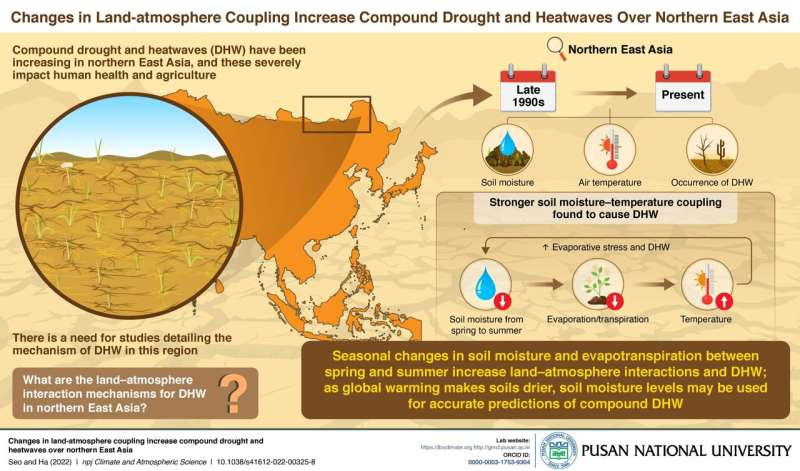This article has been reviewed according to Science X's editorial process and policies. Editors have highlighted the following attributes while ensuring the content's credibility:
fact-checked
proofread
Researchers uncover causes for increased compound droughts and heatwaves in East Asia

With global warming on the rise, the severity and frequency of extreme weather events are also rising dramatically; this includes an increase in the number of compound extreme events. The latter term describes scenarios in which bad weather and climate events combine together, making the event more devastating than a separate weather and climate event.
Compound drought and heatwaves (DHWs), for example, can cause massive damage to society through agricultural losses, wildfires, and deaths. Thus, there has been a lot of research into the mechanisms of these DHWs based on the interaction between land and the atmosphere. However, most previous studies have primarily focused on Europe, with little research looking at DHW mechanisms in northern East Asia, a region that has been experiencing an increased occurrence of DHWs since the late 1990s.
Fortunately, a team of researchers led by Professor Kyung-Ja Ha from Pusan National University in South Korea, has stepped in to bridge this gap. In their paper published in npj Climate and Atmospheric Science, the team looked at the occurrence of DHWs in northern East Asia by exploring the soil moisture–temperature coupling.
According to Prof Ha, "Regional differences in temperature and precipitation can have a large impact on compound extreme events. By looking at the connection between soil moisture and air temperature, we were able to find the land-atmosphere interaction that serves as the mechanism for the occurrence of DHWs in this specific region."
The team studied the aforementioned data, along with the occurrence of DHWs for regions in northern East Asia, like parts of northern China and eastern Mongolia, from 1980 to the present day. They found that, since the late 1990s, the continuous lack of moisture in the soil from spring to summer led to reduced evaporation and transpiration of water from the soil, which increased evaporative stress and amplified heatwaves, triggering a compound DHW that led to a further reduction in soil moisture.
This increased moisture–temperature coupling enhances land–atmosphere interactions, leading to compound DHWs in the region.
"Compound DHWs can cause damage, often times more than either droughts or heatwaves alone, thus understanding them is important for society to better handle the risks associated with these events. As global temperatures keep increasing, soil moisture deficits are bound to increase, causing more DHWs in the region. Understanding and predicting them is going to be of utmost importance. Our study shows that soil moisture may be used to predict the occurrence of DHWs in the region," concluded Prof Ha.
Understanding the complicated dynamics of compound extreme events is crucial for societal safety, and this study takes us one step closer towards this goal. We can then learn to combat the increasing risks associated with extreme events, especially in the face of global climate change.
More information: Ye-Won Seo et al, Changes in land-atmosphere coupling increase compound drought and heatwaves over northern East Asia, npj Climate and Atmospheric Science (2022). DOI: 10.1038/s41612-022-00325-8
Provided by Pusan National University



















